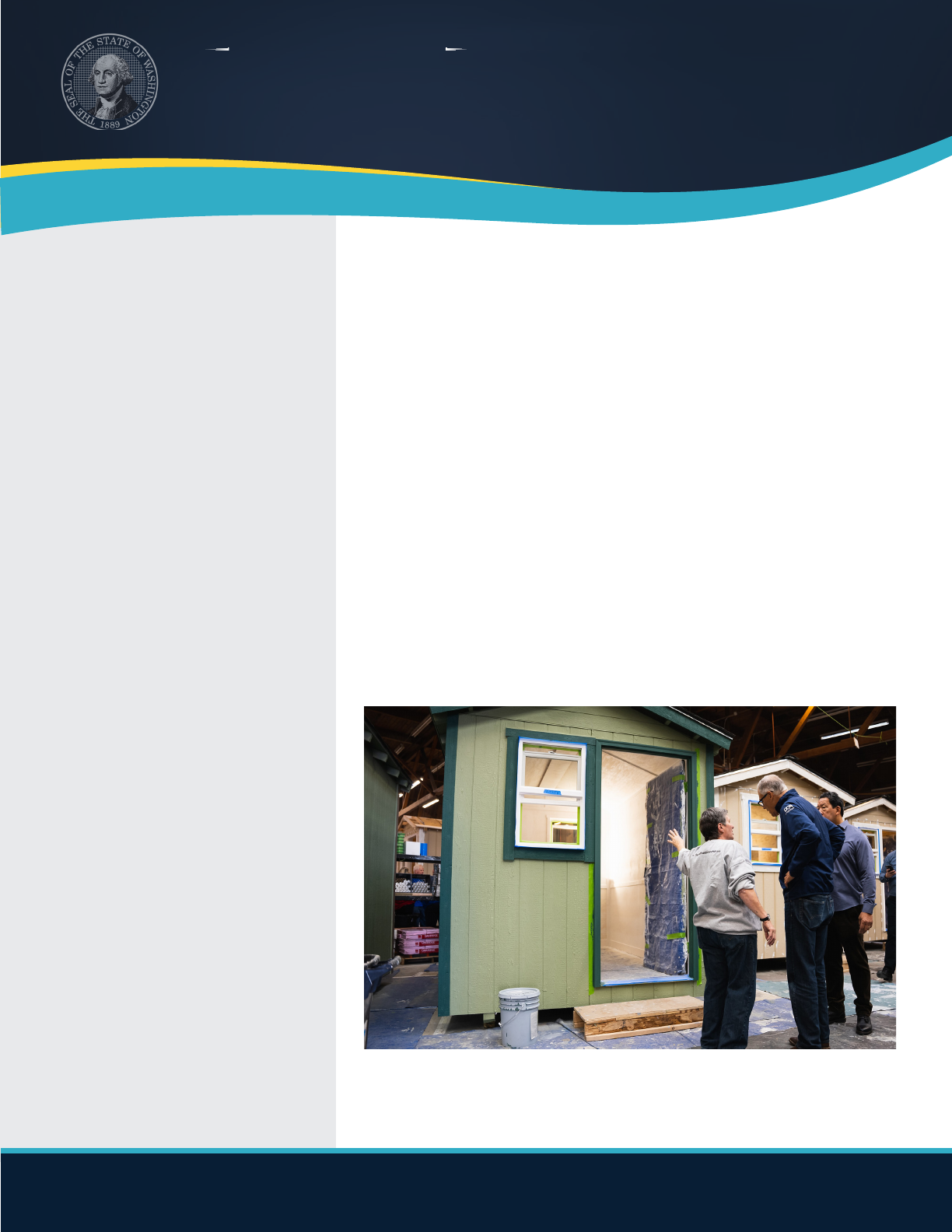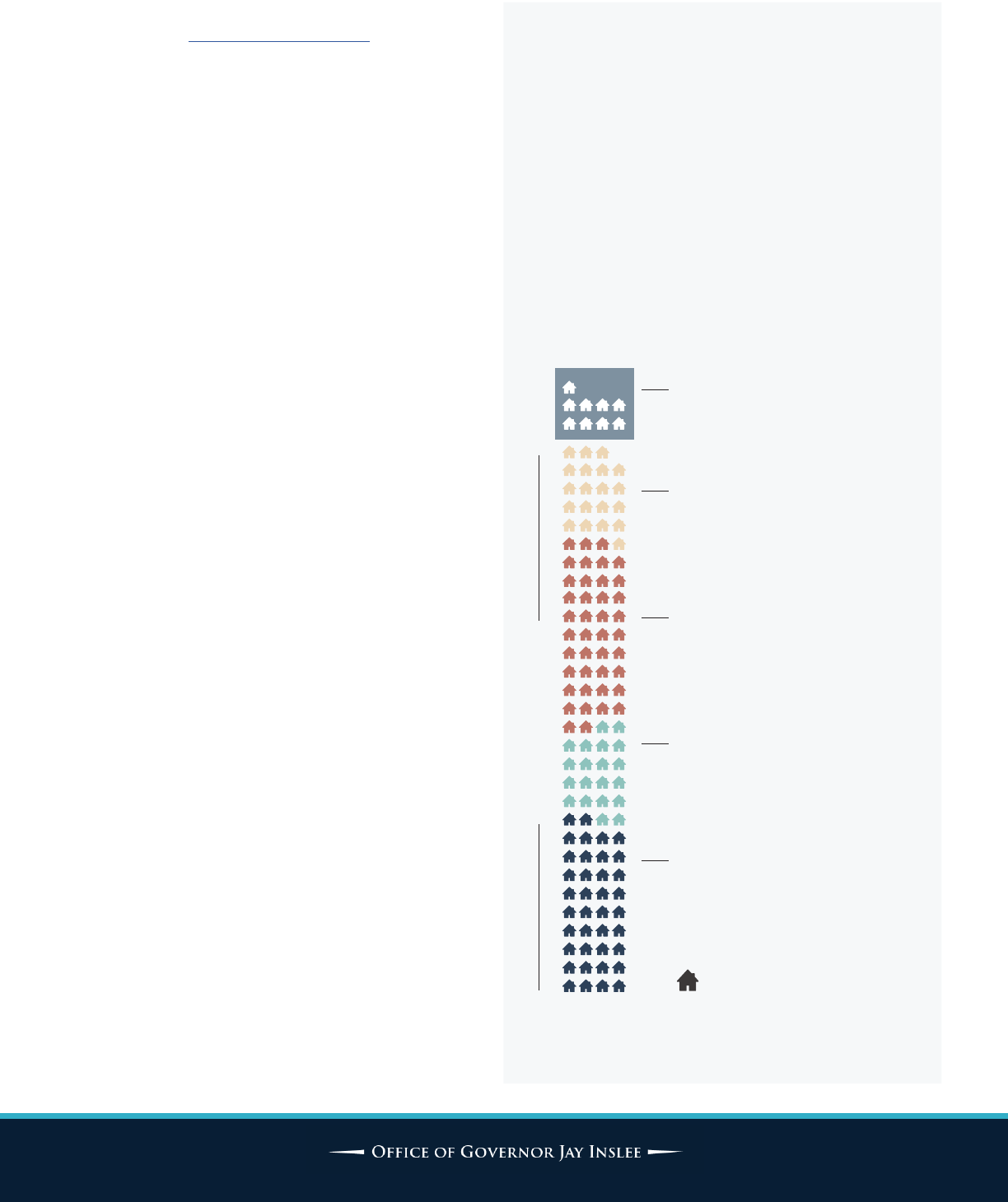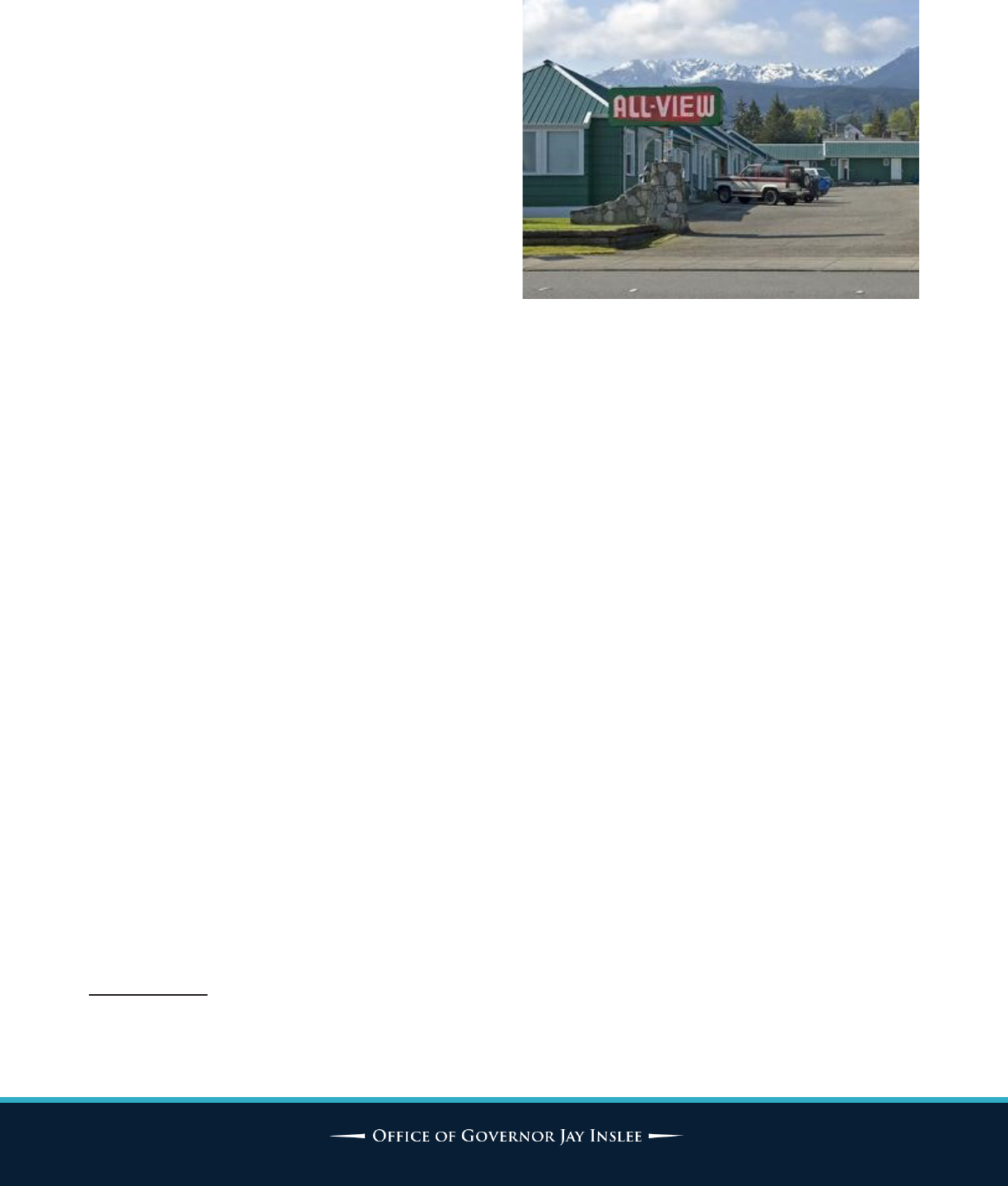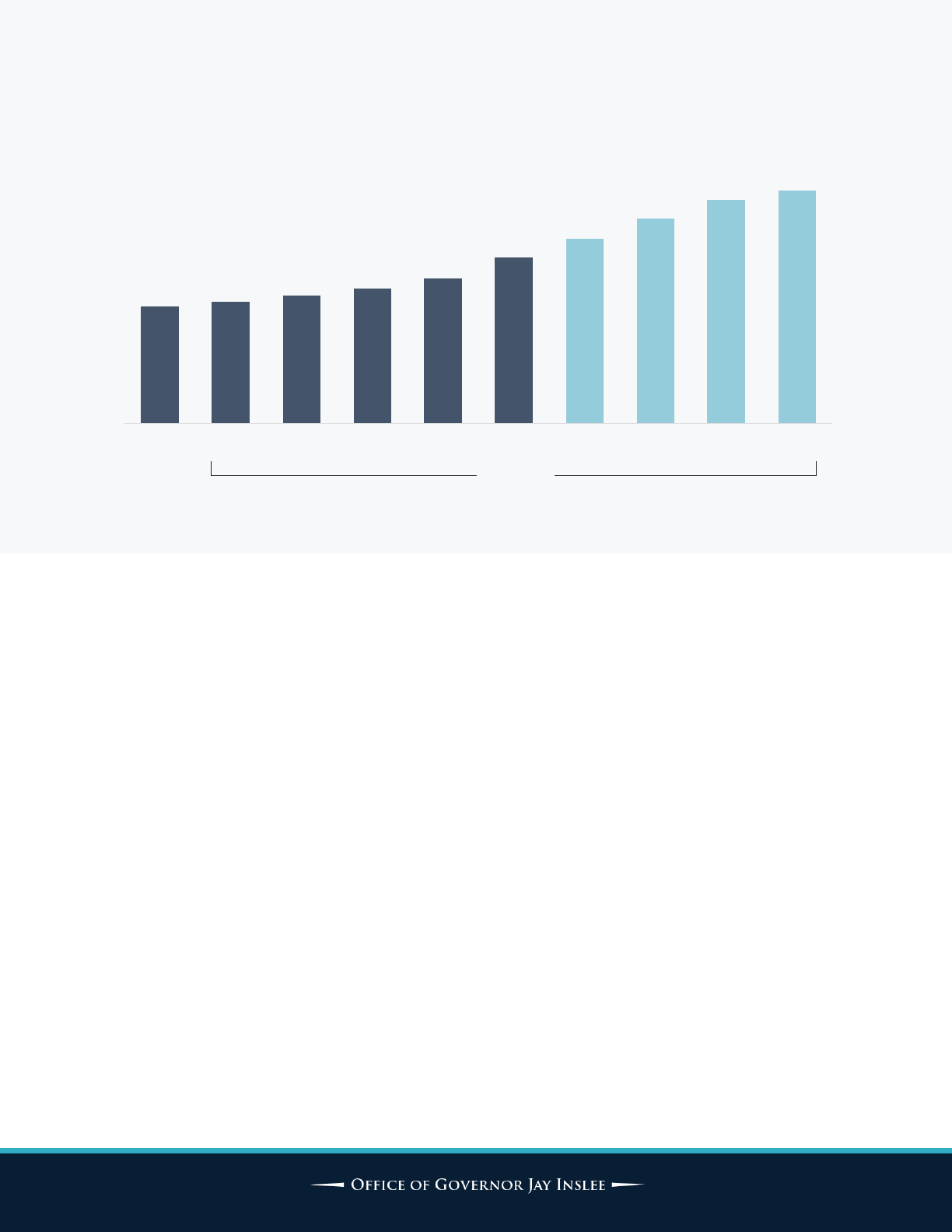
Jay Inslee
Washington Governor
www.governor.wa.gov
1
In recent years, Washington has
taken unprecedented actions to
speed up housing and shelter
construction and combat housing
and homelessness crises across
the state. Gov. Jay Inslee is putting
forward an ambitious housing
plan to fast-track construction
so we can reduce homelessness
and increase the availability of
aordable housing.
Sound Foundations NW builds tiny homes at their ‘Hope Factory’ with volunteer labor. Gov. Jay Inslee
and Seattle Mayor Bruce Harrell take lessons from Sound Foundations NW Director Barb Oliver before
they help build a tiny home. (Oce of the Governor photo, October 2022)
Continued momentum, faster
construction needed to tackle housing
and homelessness crises
Over the past two years, Gov. Jay Inslee and the Legislature have put more
than $2.4 billion toward a wide range of eorts to reduce homelessness and
address the state’s growing housing shortage. Working in partnership with local
communities and organizations, the state has helped nd shelter and support
for thousands of people living outside. The state worked to increase the supply
of aordable housing and provided vital assistance to tens of thousands more
people who were at increased risk of becoming homeless during the pandemic.
But the scale of Washington’s housing shortage and resulting homelessness
can only be solved by speeding up construction of thousands more housing
units — from emergency housing to multifamily developments and aordable
housing.
Policy Brief
December 2022

2
Washington’s 2022 point-in-time count found
nearly 13,000 individuals live outside and are
unsheltered across the state — up from about
10,800 in 2020. If you include those living in
shelters, the total count of individuals experiencing
homelessness grew from about 22,900 in 2020 to
more than 25,400 in 2022.
Meanwhile, the state faces a signicant shortage
of housing — now and well into the future. Of
the available housing for rent, 157,000 units are
out of reach for low- and extremely low-income
renters. And we need to build more housing to
accommodate the increasing population: various
reports show that the state’s overall housing
construction decit falls somewhere between
80,000-140,000 units, making Washington fth in
the nation for under-production of housing.
Due in large part to the signicant shortage of
housing, the median home price in Washington
increased nearly 14% from 2019 to 2022. The same
has been happening in many other states —
nationally, home prices increased nearly 19% from
early 2021 to early 2022.
As people continue to move to Washington for our
strong economy, temperate climate, natural beauty
and quality of life, we need signicant investments
and policy changes to keep up with housing
demand.
By early 2023, the Department of Commerce, for the
rst time, will publish data on projected housing
needs for each county, including the anticipated
needs for moderate, very low and extremely low-
income households. Preliminary estimates of the
statewide need for new housing development over
the next 20 years suggest that the state will need
more than 1 million additional units to keep pace
with population growth. More than half of this need
is for aordable housing for households under 50%
Sources: Department of Commerce and U.S. Census
Washington needs more than
1 million additional homes by 2044
We need more housing for households of all
incomes, and especially lower-income households.
As of July 2021, Washington had 3.25 million homes. By
2044, Washington will need more than1 million additional
units to accommodate the growing population. That
means 45,900 homes— including state-fundedaordable
housing—will need to be built every year for the next 22
years to achieve this goal.
Types of homes we need
1 million + homes breakdown
116,114 units for extremely
low-income households that
also need support services
(permanent supportive housing)
Need an additional 91,706
units for temporary emergency
housing/shelter
409,472 units for low-income
households at or below 50%
area median income (AMI)
196,074 units for households that
earn greater than 50-100% AMI
379,937 units for households
that earn more than 100% AMI
=10,000 homes

3
of the area median income.
1
It will likely require public
funding to be built, maintained and to provide wrap-
around services. This includes over 116,000 units of
housing combined with supportive services and over
91,000 units of emergency housing or shelter.
The state’s aordable housing shortage is more
profound for Black, Indigenous and people of color
(BIPOC). And, overall home ownership among
BIPOC households is much lower than it is for white
households.
Last year, legislators increased funding for the
state’s aordable housing programs to support the
construction and acquisition of an estimated 3,890
aordable housing units across the state, more than
double the amount of past budgets. Legislators also
added $300 million to the rapid capital housing
acquisition program. Local communities are using
these funds to purchase and quickly convert
properties such as hotels or apartment buildings into
supportive shelters or housing.
Within the rst year of the rapid acquisition program,
11 new facilities were opened, serving more than 708
residents. The Department of Commerce has awarded
funding for an additional 21 projects in 12 counties
that will provide another 1,002 housing units.
Another example is the state’s new Right of Way
Safety Initiative, which transitions people living
in encampments along state highways to safer
shelter and housing options. Three state agencies
— Transportation, Commerce and the State Patrol
— are working with cities, counties and nonprot
organizations to identify sites and conduct outreach to
those living in encampments.
Since the $143 million initiative was launched last
spring, about 170 individuals living in encampments in
ve counties were transitioned to housing or shelter.
1
Median Family Income, or Area Median Income (AMI), is the median household income adjusted for household size, for the county where
the household is located. This standard is developed by The Department of Housing and Urban Development (HUD), which publishes this
income standard for each county on an annual basis.
Most remain housed, thanks to extensive eorts to
connect individuals to appropriate services.
Highlights of Inslee’s 2023–25
housing and homelessness
package
During the pandemic, a large infusion of COVID-19
relief funding from the federal government supported
the state’s eorts to help people living outside and
keep others in their homes. For example, the state
used about $1 billion of that money to provide rent
and utility assistance to more than 92,000 households
and expand shelter services by at least 2,000 units
statewide.
But with the federal COVID-19 funding winding
down and a continued rise in housing prices and
homelessness, the state must nd new ways to
The All-View Motel in Port Angeles was acquired by Peninsula
Behavioral Health with funding from Commerce’s Rapid Capital
Housing Acquisition program. It includes 25 rental units for individuals
experiencing homelessness, with three set aside for families with
children and 23 set aside for people with chronic mental illness.

4
quickly address its aordable housing shortage and
homelessness crisis. The most crucial aspect to this
work is speed – we need to close existing housing
gaps as soon as possible and get back on pace with
population growth. The governor is proposing a
statewide voter referendum that would enable the
state to raise $4 billion over the next six years by
issuing bonds outside Washington’s debt limit. The
proposal does not include any tax or fee increases.
The new funding provides the cornerstone of the
governor’s 2023–25 housing and homelessness
plan, and would allow the state to continue rapidly
funding and constructing housing projects across the
state. The governor’s proposal calls for investing over
$1.3 billion in state capital and operating funds on a
wide range of housing and homelessness initiatives.
Besides maintaining 2,000 existing shelter beds and
support services that would otherwise be lost, over
the next two years the plan would add an estimated
7,500 aordable housing units and preserve another
2,700 units. This plan also includes assistance for
communities to plan for and accommodate their
unique housing needs for all income levels over
the next 20 years and actions to speed up housing
development statewide.
Capital budget
Increase Housing Trust Fund
investment in aordable housing
supply
The governor continues to look for solutions to
increase our housing supply, particularly for those
at the highest risk for homelessness, and low- and
middle-income households that cannot aord, or
pay a high percentage of their income toward, rents.
The governor’s budget proposes signicant new
funding for the state’s Housing Trust Fund to construct
2
Permanent housing where long-term leasing or rental assistance is provided in combination with services for households with one member
(adult or child) living with a disability.
aordable housing units that serve and benet
low-income and special needs populations. This
includes people with chronic mental illness, people
with intellectual and/or developmental disabilities,
farmworkers, people experiencing homelessness, and
people in need of permanent supportive housing.
Multifamily rental housing units
There is a big demand for multifamily rental housing
development. Communities are now using sales
tax revenue generated by the 2019 Encouraging
Investments in Aordable and Supportive Housing
Act to support projects. The new revenue source is
generating nearly $50 million annually, but these funds
are insucient for local government to construct
needed projects on their own.
The governor’s proposal, combined with existing funds
and leveraged private market funding, will create
approximately 17,720 multifamily rental housing units
in the next six years, including 4,960 units during the
2023-25 biennium.
($440 million, bonds)
Permanent supportive housing
In 2022, the Apple Health and Homes Act codied that
medical providers need the ability to refer people to
housing. Foundational Community Supports, a state
program that is one of the rst in the nation of its
kind, helps those experiencing chronic homelessness.
New investments in these programs will help address
future demand and produce improved public health
outcomes. These will also increase eective hospital
capacity by allowing more patients to be successfully
discharged from their treatment and into stable
housing.
The governor’s proposed investments in permanent
supportive housing
2
will acquire, rehabilitate or
construct approximately 750 permanent supportive

5
housing units in the 2023-25 biennium and 2,900 units
over the next six years. It also helps close the existing
gap of aordable permanent supportive housing in
Washington, estimated at over 17,000 units, according
to Corporation for Supportive Housing data.
($100 million, bonds)
Homeownership opportunities
The Homeownership program within the Housing
Trust Fund program assists low-income (under 80%
of the area median income) rst-time homebuyers.
Assistance can include help with down payments
and closing costs, community land trust models,
sweat-equity models, funding for new construction,
acquisition, and/or rehabilitation, manufactured home
community models and homeowner cooperative
models.
The governor’s proposed investment recognizes
there is a signicant gap in homeownership
assistance to socially disadvantaged communities
and to organizations that provide housing to socially
disadvantaged communities. This funding will help
approximately 1,100 rst-time homebuyers in 2023-25
biennium and 4,600 total in over six years. The funding
will support socially disadvantaged households with
incomes at or below 100% of the area median income,
and covenants placed on the property will ensure
aordability for 25 years or more.
($75 million, bonds)
Housing for people with developmental
disabilities
There are only 1,400 Housing Trust Fund units available
for the estimated 37,000 people with intellectual and/
or developmental disabilities who need housing. Most
of these individuals rely primarily on Supplemental
Security Income, which places them below 30% of
the area median income. At those income levels, rent
revenue from these units is insucient to spur housing
development. The governor’s proposed investment
in housing for people with intellectual and/or
developmental disabilities will create an estimated
275 aordable housing units in 2023-25 biennium
and over 1,000 units over the next six years. As part
of this proposal, the Department of Commerce will
coordinate with the Department of Social and Health
Services on any needed supportive services.
($25 million, bonds)
Housing aordability preservation
Over the last three decades, Washington has invested
over $1.5 billion in aordable housing, some of which
requires renovation to continue being safe and
livable. The governor’s proposed investment will be
distributed through the Housing Trust Fund’s Portfolio
Preservation program and the Continuing Aordability
program. This will help us maintain these critical
investments across the state.
Nearly 1,500 apartments buildings with approximately
9,850 units will receive health and safety capital
upgrades through the Housing Trust Fund Portfolio
Preservation funding. Approximately 150 units will
be preserved through the Continuing Aordability
program. Funding will also help maintain
approximately 36 manufactured or mobile home
communities operated by nonprot cooperative
organizations or housing authorities that benet
people and households at or below 80% of the area
median income.
($58 million, bonds)
Encampment Resolution program rapid
capital housing
Proposed funding will help acquire real property for
rapid conversion into enhanced emergency shelters,
transitional housing and permanent supportive
housing. The new housing will transition people

6
experiencing unsheltered homelessness — including
individuals residing on state-owned rights of way —
into safer and more stable housing. This additional
investment builds on the state’s Rights of Way
Initiative, which the governor and the Legislature
funded this year. This new investment will create
approximately 400 units.
($60 million, bonds)
Investments to accelerate
creating aordable housing units
The governor’s housing and homelessness plan takes
a holistic approach that focuses on reinvesting in
existing programs to increase housing aordability
and availability and addresses some of the root causes
of the housing supply crisis. It makes investments
to address local planning, streamline regulatory
environments, assist local governments and private
developers, and to create new pathways and
incentives to increase housing development.
Aordable housing connections to
basic infrastructure
Communities face signicant pressure to identify
appropriate locations for aordable housing
and ways to support it. The governor’s proposed
funding will help leverage those eorts and assist
local governments with one-time costs associated
with infrastructure. It will also oer utility providers
reimbursement for aordable housing-supportive
fee waivers. This funding will reduce the cost of
approximately 10,000 aordable housing connections
to regional water, sewer and stormwater systems.
($50 million, bonds)
Transit-oriented housing development
housing partnership
This proposal establishes a new public-private
partnership focused on increasing supply, encouraging
aordability, and stimulating the overall production
of transit-oriented housing development. State and
46,400
48,100
50,800
53,400
57,600
65,700
73,200
81,100
88,800
92,400
Est. number of
units available
as of July 1,
2012
2013-15 2015-17 2017-19 2019-21 2021-23 2023-25 2025-27 2027-29 2029-31
Expanding Washington's supply of affordable housing
Gov. Inslee’s plan would add an estimated 7,400 state-funded affordable housing units during the 2023-25 biennium,
and 26,600 units over the next four biennia
Data source: Office of Financial Management
Estimated number of units available after 2012
Expanding Washington’s supply of aordable housing
Gov. Inslee’s plan would add an estimated 7,500 state-funded aordable housing units
during the 2023-25 biennium, and 26,700 units over the next four biennia
Source: Oce of Financial Management
Estimates

7
private investment funding will provide grants to for-
prot and nonprot housing developers, and public
entities to carry out projects and to address funding
gaps that prevent ongoing construction from being
completed.
($75 million, bonds and other funds)
Aordable Workforce Housing
Accelerator pilot program
This proposal creates a new low-interest revolving
loan program administered by the Washington
State Housing Finance Commission. This program
accelerates aordable housing development for
households at 50-80% of the area median income.
And, it will remain aordable for at least 60 years.
Funding may be awarded to for-prot and nonprot
developers, public housing authorities, public
development authorities and others.
($50 million, bonds)
Land acquisition for aordable housing
Provides one-time funding to support the Housing
Finance Commission Land Acquisition program,
which helps developers purchase land for aordable
housing (rental or homeownership) developments.
By increasing funding for this revolving loan program,
the commission can help more community-based
organizations — including by-and-for organizations
— develop approximately 1,750 critically needed
aordable housing units across the state.
($35 million, bonds)
Expedite permitting and increase
capacity
The governor is requesting legislation to provide
grants to local governments so they can scale up
their permitting departments and streamline permit
approval processes to get housing built faster.
Additional grant dollars will allow local jurisdictions to
upgrade outdated permitting software and convene
a work group to improve permitting processes
statewide. The policy requires local governments to
exempt project permits for simple interior alterations
to relieve pressure on already strained permitting
departments.
($15 million, bonds)
Aordable housing predevelopment
and preconstruction assistance
The Department of Commerce will provide grants
for project design, architectural and engineering,
bid documents, environmental and archeological
studies, and other preliminary phases of development
necessary to accelerate the completion of aordable
multifamily housing and homeownership projects.
($10 million, bonds)
Aordable housing cleanup grant
program
The Department of Ecology currently oers grants to
public, nonprot and private entities that remediate
brownelds to develop aordable housing. Additional
funding for the program will support cleanup on
enough properties to make space for approximately
395 aordable housing units.
($12.3 million, Model Toxics Control Capital Account)
Operating budget
Maintain current levels of housing
and homelessness services
Emergency housing and shelter
Before the COVID-19 pandemic, there were not
enough shelter beds in the state to accommodate
everyone living outside or in places unt for habitation.
Since then, rents have risen signicantly, increasing the
need for traditional congregate and non-congregate
shelter and other emergency housing options. The
governor’s proposed investment includes funding to

8
ensure that 2,000 shelter beds and other emergency
housing units statewide are not lost due to the lapsing
of one-time resources.
($153 million, General Fund – State, Coronavirus State
Fiscal Recovery Fund – State)
Encampment Resolution program
In 2022, the governor proposed and the Legislature
funded a state Rights of Way Initiative to help move
individuals residing on state rights of way into safer
and better places to live. Since last spring, about 170
individuals obtained housing through the initiative,
the majority of whom remain housed. Proposed
funding will continue this eort. The Department
of Commerce — in partnership with the state
Department of Transportation, Washington State
Patrol, local governments and nonprots — will
provide grants for the cost of outreach, temporary
shelter, move-in costs, transportation, accessing IDs,
housing application costs and other housing-related
needs for individuals who reside on state rights
of way and other encampments. The Department
of Transportation will use funding to remediate
encampment sites after housing is secured.
($68 million, – GF-S)
Homeless youth programs
Each night, thousands of youth sleep without the
safety or stability of a family or home. The Oce
of Homeless Youth within the Department of
Commerce leads the state’s eort to prevent and
reduce youth and young adult homelessness through
several grant programs and partnerships. Without
additional funding, two of the grant programs would
be required to reduce services in the 2023-2025
biennium. These grants allow licensed youth shelters
to provide behavioral health services and help prevent
youth exiting public systems of care from entering
homelessness.
($6.5 million, GF-S)
Homeless service contracts: accounting
for ination
Grants issued through the Department of Commerce’s
Housing Division do not adjust over time to keep up
with the increased cost of rent, goods and services.
This results in fewer people being served over time,
and higher rates of turnover among homeless service
providers. The governor proposes an across-the-board
5% increase to homeless service contracts so grantees
can achieve the same performance outcomes that the
department expects.
($6.3 million, – GF-S)
Landlord Mitigation program
The Landlord Mitigation program within the
Department of Commerce provides incentive funding
to landlords to work with renters receiving rental
assistance. The program will pay landlords up to $5,000
to repair damages to rental units or funding to cover
up to 14 days’ rent loss. The program is currently at
capacity and approximately 1,300 claims have been
approved, but the department lacks the funds to make
payments. Funding will address these approved claims.
($8 million, GF-S)
Document recording fee
Homelessness services in Washington mainly rely on
revenues generated by a certain document fee. This
fee comes from document assessments that counties
record for mortgage originations and renances,
referred to as the “document recording fee.” Likely
a result of increasing interest rates, the number of
mortgage originations and renances have declined
signicantly in the last year, leading to a decrease in
document recording fee revenues. We don’t know if or
how this downward trend may continue throughout
the 2023-25 biennium. The governor proposes adding
funding to the Home Security Fund Account to oset
lost revenue so homeless response activities can
continue without a service reduction.
($40 million, GF-S)

9
Housing and Essential Needs
The Housing and Essential Needs program (HEN)
provides temporary rental assistance, services
connected to housing stability and limited
essential needs items such as personal hygiene and
transportation for individuals who cannot work
due to a disability. Unfortunately, people eligible
for HEN assistance are being turned away because
there isn’t enough program funding. This increased
homelessness for this vulnerable population. An
additional investment means HEN can serve more
people. Additionally, the Department of Commerce
will analyze the program to identify improvements,
and determine the amount of funding it needs so that
no person who is eligible for HEN is turned away.
($15 million, GF-S)
Plan for housing supply
Plan for and accommodate housing
needs
Approximately 70% of the housing in Washington is
single-family housing, the majority of which tends
to be out of reach for many low and moderate-
income households. In January 2023, the Department
of Commerce will publish projections of housing
needs for each income segment in each county
statewide. Cities will soon be required to plan for
and accommodate housing needs for each income
segment, including low- and extremely low-income
households. To accommodate the housing needs for
all income levels, many local jurisdictions will need
to begin planning for higher density development,
development along transit lines, allowing smaller and
multiunit housing and planning for added emergency
shelter, transitional housing and permanent
supportive housing. This will require examining plans
and regulations, updating zoning codes, assessing
environmental impacts and implementing new
programs. The governor proposes grant funding
to local jurisdictions to complete this work, along
with funding for state agencies to provide technical
assistance and support. Funding is also proposed to
support legislation that will encourage more middle
housing production.
($17.4 million, GF-S)
Streamline permitting
In recent years, a backlog of processing building
permits have slowed building eorts. The governor is
requesting legislation to reduce permit timelines by
requiring local governments to exempt permit review
for simple home interior alterations, providing grants
to local governments to implement consolidated
permit review processes and a grant that enables
local governments to receive permit applications
electronically. The governor proposes funding to
implement this bill in both the operating and capital
budgets.
($4 million, GF-S)
Address homeownership disparities
BIPOC homeownership
In the 2021-23 operating budget, the Legislature
directed the Department of Commerce to
convene a diverse stakeholder work group
to assess homeownership disparities among
BIPOC in Washington. The work group recently
released its ndings, which contain 12 ready and
actionable priority recommendations, some that
the governor proposes addressing through capital
budget appropriations. In the operating budget,
the governor specically proposes addressing
the recommendation to “fund culturally specic
organizations for outreach to increase the visibility of
and access to homeownership assistance programs
for BIPOC communities” (Improving Homeownership
Rates for Black, Indigenous and People of Color in
Washington, 2022). This means nonprot entities will
receive funding to build capacity so they can better
develop aordable homeownership units and assist
prospective buyers.
($5 million, – GF-S)

10
Behavioral health housing supports
Address chronic homelessness
Homelessness often interferes with individuals’
ability to obtain behavioral services and interferes
with recovery. The governor proposes a series of
interventions to individuals with behavioral health
needs to help them obtain and maintain housing. This
includes a pilot program in one rural and one urban
area to connect individuals in shelters or behavioral
health clinics to housing through the Housing
Assistance through Peer Services (HARPS) program,
services to help seniors escape chronic homelessness
and funding enhancements to newly created
programs in the 2022 supplemental budget.
($8.6 million – GF-S)
Permanent supportive housing
Permanent supportive housing pairs long-term rental
assistance with case management and supportive
services. This is a highly eective housing solution for
the most vulnerable, chronically homeless people.
As we build more permanent supportive housing
units, there will be costs for wrap-around services to
keep people inside. The governor proposes additional
funding for grants to support the building operation,
maintenance and service costs of permanent
supportive housing projects funded through the
Housing Trust Fund.
($15 million – GF-S)

11
Housing and homelessness strategic agenda
Summary of investments, 2023-25 Biennial
Focus Area Items Agency Amount
Increase Housing Trust Fund
investment in aordable housing
Multi-family rental housing Commerce $440,000,000
Permanent supportive housing Commerce $100,000,000
Homeownership opportunities Commerce $75,000,000
Housing for people with
developmental disabilities
Commerce $25,000,000
Housing aordability preservation Commerce $50,000,000
Acquisition and preservation of
mobile homes
Commerce $8,000,000
Total $698,000,000
Accelerate creation of aordable
housing
Aordable Housing Connections to
Basic Infrastructure (CHIP)
Commerce $50,000,000
Transit-oriented housing
development partnership
Commerce $75,000,000
Rapid acquisition of housing for
unsheltered people
Commerce $60,000,000
Aordable workforce housing
accelerator pilot program
Commerce $50,000,000
Land acquisition for aordable
housing
Commerce $35,000,000
Total $270,000,000
Expedite permitting and increase
capacity
Consolidated permit review Commerce $15,000,000
Aordable housing predevelopment
and preconstruction
Commerce $10,000,000
Aordable housing cleanup grant
program
Ecology $12,259,000
Total $37,259,000

12
Focus Area Items Agency Amount
Maintain current levels of
housing and homelessness
services
Emergency housing and shelter Commerce $153,000,000
Encampment Resolution Program Commerce,
WSDOT
$68,000,000
Homeless Youth Programs Commerce $6,500,000
Homeless services contracts Commerce $6,300,000
Landlord Mitigation Program Commerce $8,000,000
Document recording fee Commerce $40,000,000
Housing and Essential Needs Commerce $15,000,000
Total $296,800,000
Planning for Housing Supply Plan for and accommodate housing
needs
Commerce/local
governments
$17,400,000
Streamline permitting Commerce $4,000,000
Total $21,400,000
Address homeownership
disparities
BIPOC homeownership organizations Commerce $5,000,000
Total $5,000,000
Behavioral health housing
supports
Address chronic homelessness Health Care
Authority
$8,600,000
Permanent supportive housing
operations & maintenance
Commerce $15,000,000
Total $23,600,000
Grand Total $1,352,059,000
